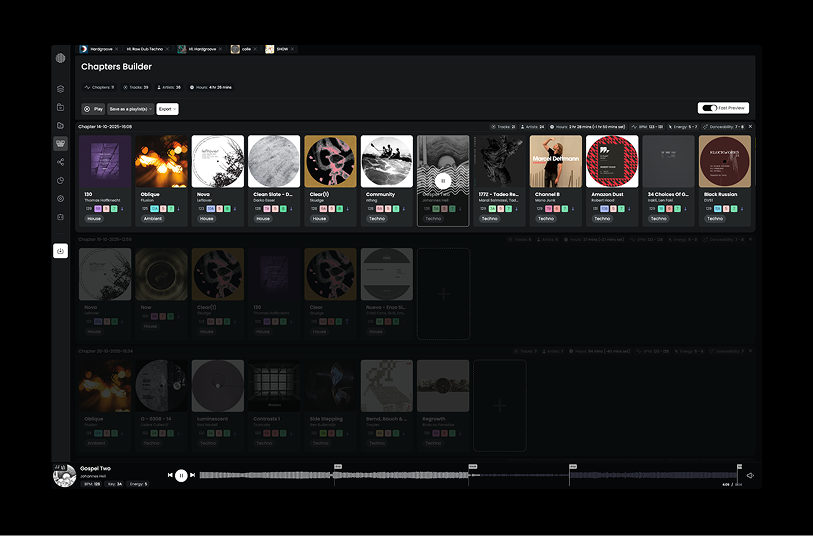
An Introduction to Harmonic Mixing
Harmonic mixing is a skill that can put your mixes a cut above the rest. It involves blending tracks that share compatible musical keys, creating seamless transitions and a harmonious flow that captivates the audience.
In this guide, we'll explore the fundamentals of harmonic mixing and introduce you to essential tools that make this technique accessible and effective.
Understanding Musical Keys
Central to the art of harmonic mixing is a grasp of musical keys. Each track possesses a distinct key, setting its tonal centre. Keys are represented by letters like C, D, or E, and they can be major or minor. To harmonically mix, it's ideal to choose tracks with keys that complement or align.

The Circle of Fifths
The Circle of Fifths is a visual aid that assists DJs in recognizing keys that work well together. It arranges all 12 musical keys in a circular pattern, revealing which keys are harmonically related.
The tracks on the outside of the wheel are ‘Major keys, and the Tracks on the inside are minor keys (represented by the lowercase M).
Tracks adjacent to the circle generally blend smoothly in any direction. For instance, if you're playing a track in C major, transitioning to tracks in G major or F major should flow seamlessly.

The Camelot Wheel - Key matching for DJs
The Camelot Wheel is a specialized tool designed to facilitate seamless transitions between tracks. It introduces a unique coding system, combining numbers (ranging from 1 to 12) with letters (A and B), assigned to each key. This intuitive system empowers DJs to identify compatible keys effortlessly.
Adjacent numbers on the Camelot Wheel, like 2A and 2B, signify keys that harmonize smoothly, allowing DJs to transition seamlessly. It extends the compatibility across the wheel, enabling transitions from 2A to 3A or even 2A to 1A. This ingenious tool serves as a safeguard against dissonant clashes, ensuring that the mix remains harmonically balanced.
DJ library management software such as DJOID utilize the Camelot wheel to suggest groups of tracks that flow perfectly together, so you don't need to get stuck in the numbers. Click here to learn more about DJOID’s key detection and set building capabilities.

Going deeper
Okay, so you now have the basics of what keys will blend into each other, but what keys should you choose? It turns out that each key has a subtle different nuance and feel to the next, that goes beyond the usual major/minor attributes.
Note: there are more keys than the major or minor scales as well such as mixolydian, in sen, and full tone which we aren't going to mention in this article, but those interested in deeper music theory, especially for production should definitely explore further.
- C MAJOR (1A): Innocently Happy, a journey through unbridled joy.
- C MINOR (1B): Innocently Sad, Love-Sick, a tender serenade of longing hearts.
- C# MINOR (2B): Despair, Wailing, Weeping, a haunting echo of melancholy.
- DB MAJOR (2A): Grief, Depressive, a somber reflection on profound loss.
- D MAJOR (3A): Triumphant, Victorious War-Cries, a march of resounding triumph.
- D MINOR (3B): Serious, Pious, Ruminating, a contemplative moment of introspection.
- D# MINOR (4B): Deep Distress, Existential Angst, a plunge into the depths of despair.
- EB MAJOR (4A): Cruel, Hard, Yet Full of Devotion, an unyielding testament of unwavering dedication.
- E MAJOR (5A): Quarrelsome, Boisterous, Incomplete Pleasure, a tempestuous dance of conflicting emotions.
- E MINOR (5B): Effeminate, Amorous, Restless, a tale of restless hearts entwined.
- F MAJOR (6A): Furious, Quick-Tempered, Passing Regret, a whirlwind of impassioned sentiments.
- F MINOR (6B): Obscure, Plaintive, Funereal, a solemn elegy for bygone days.
- F# MAJOR (7A): Conquering Difficulties, Sighs of Relief, a triumphant ascent over adversity.
- F# MINOR (7B): Gloomy, Passionate Resentment, a tumultuous sea of conflicting passions.
- G MAJOR (8A): Serious, Magnificent, Fantasy, an epic odyssey through realms of grandeur.
- G MINOR (8B): Discontent, Uneasiness, a journey through the labyrinth of discontented hearts.
- AB MAJOR (9A): Death, Eternity, Judgement, an introspective contemplation of life's impermanence.
- AB MINOR (9B): Grumbling, Moaning, Wailing, a mournful lament echoing through the ages.
- A MAJOR (10A): Joyful, Pastoral, Declaration of Love, a jubilant proclamation of boundless affection.
- A MINOR (10B): Tender, Plaintive, Pious, a gentle whisper of heartfelt devotion.
- BB MAJOR (11A): Joyful, Quaint, Cheerful, a merry frolic through sunlit meadows.
- BB MINOR (11B): Terrible, the Night, Mocking, a haunting nocturne of chilling laughter.
- B MAJOR (12A): Harsh, Strong, Wild, Rage, a tempestuous tempest of unbridled passion.
- B MINOR (12B): Solitary, Melancholic, Patience, a quiet solitude, bearing the weight of time.
So imagine if you were to combine these feelings into a set intentionally!
Here is an example of a set that works perfectly with the circle of fifths, and also tells a specific story
- D MINOR : Serious, Pious, Ruminating
- A MINOR : Tender, Plaintive, Pious
- C MAJOR : Innocently Happy
- G MAJOR : Serious, Magnificent, Fantasy
- D MAJOR : Triumphant, Victorious War-Cries
- A MAJOR : Joyful, Pastoral, Declaration of Love
Watch out when changing BPM.
You will lose the original key of the track if you speed it up or slow it down, unless you have “master tempo” selected on CDJs. This will allow you to change the speed of the track without affecting the pitch, but it will reduce the audio quality of the track. The loss of quality is a bit of a gray area, and whilst I wouldn't recommend it on an older model, arguably the 2000NXS and above have good enough algorithms that this effect is much less noticeable.
One tip: The better quality your audio files are, the better results you’ll get with Master Tempo. Lossless files will sound better than MP3. And, don’t even bother with MP3 which are less than 320k CBR. (Always try to use AIFF).

Software Tools for Key Detection
Several software tools are available to aid DJs in determining the key of each track. These tools save time and ensure harmonic compatibility in your mixes. Some well-known options include Mixed In Key, DJUCED, and Traktor Pro.
With these tools, organizing your music library by key becomes efficient, making it simpler to locate tracks that harmonize seamlessly during your sets.
Leave room for creativity.
While harmonic mixing provides a useful framework, remember that rules in music are meant to be broken. Trust your ears and venture into different combinations. At times, unexpected mixes can lead to the most intriguing moments in a DJ set, so have fun :)










